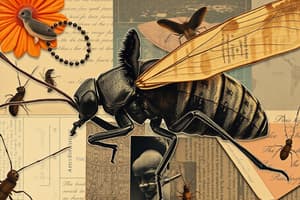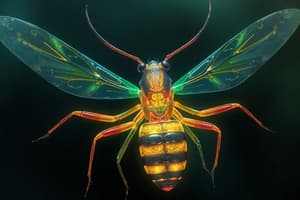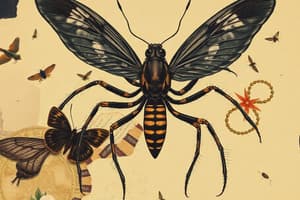Podcast
Questions and Answers
What is a defining characteristic of arthropods?
What is a defining characteristic of arthropods?
- Laying live young
- Possessing a backbone
- Having an exoskeleton (correct)
- Being warm-blooded
Which life cycle type involves stages of egg, larva, and pupa before becoming an adult?
Which life cycle type involves stages of egg, larva, and pupa before becoming an adult?
- Complex life cycle (correct)
- Non-moulting cycle
- Simple life cycle
- Mounting life cycle
What unique feature allows fleas to jump significant distances?
What unique feature allows fleas to jump significant distances?
- An enlarged third pair of legs (correct)
- Their lightweight segmented body
- A special hydraulic mechanism in their legs
- A powerful muscle structure in their wings
How do arthropods primarily take in oxygen?
How do arthropods primarily take in oxygen?
Which of the following is NOT a characteristic of arthropods?
Which of the following is NOT a characteristic of arthropods?
What is the primary method by which fleas are transmitted to their hosts?
What is the primary method by which fleas are transmitted to their hosts?
Which stage of the flea life cycle is characterized by the larvae feeding on flea dirt?
Which stage of the flea life cycle is characterized by the larvae feeding on flea dirt?
What is the most common clinical sign of flea infestation in adult animals?
What is the most common clinical sign of flea infestation in adult animals?
Which flea species is considered the most common on both cats and dogs?
Which flea species is considered the most common on both cats and dogs?
Which of the following is NOT a disease vector associated with fleas?
Which of the following is NOT a disease vector associated with fleas?
What condition can severe flea infestations lead to in kittens?
What condition can severe flea infestations lead to in kittens?
What method can be used to specifically check for flea dirt?
What method can be used to specifically check for flea dirt?
How do fleas primarily cause public health issues?
How do fleas primarily cause public health issues?
Flashcards are hidden until you start studying
Study Notes
Arthropods
- Characterized by an exoskeleton, segmented bodies, and paired sets of legs.
- Take in oxygen via holes in their outer covering.
- Have a tube-like alimentary system running through their body.
- Sensory hairs on their body detect changes in light, temperature, and movement.
- Reproduction is typically sexual, with separate sexes and most species laying eggs.
Life Cycle of Arthropods
- Can be simple (incomplete metamorphosis) or complex (complete metamorphosis).
- Simple life cycle: arthropod moults through nymphal stages while growing in size.
- Complex life cycle involves distinct egg, larva, and pupa stages before becoming an adult.
- Molting (ecdysis) is where arthropods periodically shed their exoskeleton while growing.
Arthropods of Veterinary Significance
- Include insects such as fleas and lice.
- Adults have a distinct head, thorax, and abdomen, with jointed antennae on the head, complex mouthparts, and 3 pairs of jointed legs.
- Also include arachnids such as ticks and mites.
- Spider related.
- Four pairs of legs, head and thorax fused, no antennae, no distinct mandibles
Flea Characteristics
- Small, dark brown, wingless insects with a laterally flattened body.
- Possess a segmented body structure with a distinct head, thorax, and abdomen, equipped with complex mouthparts for blood feeding.
- The third pair of legs is enlarged to jump up to 8 feet for host-to-host transmission.
- Both sexes are blood feeders.
- Only adults are parasitic.
- Undergo complete metamorphosis.
- Two main species are Ctenocephalides felis (cat flea) and Ctenocephalides canis (dog flea).
- Not host specific but are host preferential.
- Ctenocephalides felis is the most common flea found on cats and dogs, but its preferred host is cats.
- Can survive on other carnivores and rabbits.
Flea Transmission
- Mostly through indirect contact where immature stages mature in the environment and jump onto a host when hatched.
- Can also be through direct contact with an infested animal but is less common.
Flea Lifecycle
- Eggs laid on the host dry out and fall into the environment where they hatch into L1 larvae.
- Larvae feed on flea dirt and undergo two moults to become L3 larvae and soon spin into a cocoon, entering the pupal stage.
- The pupal stage varies in length as adult will emerge in correct conditions such as warm weather or when it perceives signs of a host.
- Adult will then jump onto the host.
Clinical Signs of Flea Infestation
- Mild Pruritis: Mainly in the dorsolumbar region on non-hypersensitive adult animals.
- Anaemia and death: Occurs in kittens as fleas can consume large amounts of blood per day.
- Flea Bite Dermatitis (FBD): An allergic reaction to flea saliva, causing severe pruritis and alopecia.
Fleas as Disease Vectors
- Fleas can be vectors for certain diseases such as feline infectious anaemia, feline leukemia, and Dipyldium caninum.
- Also transmit zoonotic diseases.
Diagnosis of Flea Infestation
- Can be made through direct visualization of fleas and their faeces (dirt).
- Coat brushing and the wet paper test can help identify flea dirt, which consists of digested blood.
Public Health Concerns
- Fleas can bite humans, causing localized irritation, but cannot complete their life cycle on human hosts.
- They are vectors for zoonotic diseases, including plague (Yersinia pestis) and murine typhus (Rickettsia typhi).
Studying That Suits You
Use AI to generate personalized quizzes and flashcards to suit your learning preferences.




